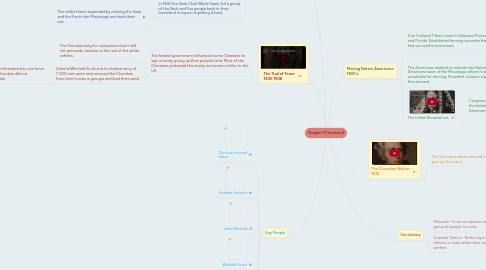
1. The Trail of Tears- 1835-1838
1.1. The federal government influenced some Cherokee to sign a treaty giving up their peoples land. Most of the Cherokee protested this treaty and wrote a letter to the US
1.1.1. The Cherokee beg for compassion but it did not persuade Jackson or the rest of the white settlers.
1.1.2. General Winfield Scott and his federal army of 7,000 men went and removed the Cherokee from their homes in georgia and lead them west
1.1.2.1. Winfield threatened to use force if the Cherokee did not cooperate.
1.1.2.1.1. The Cherokees knew if they fought back would lead to their eradication. Without dignity, the Cherokee leaders concede and set on their travel to the west.
2. Native American Resistance 1832-1842
2.1. In 1835 the Seminole people in florida were the only Native Americans to resist fight back their removal.
2.1.1. The Seminole chief Osceola and his people refused to leave florida and went to war with the United States. They joined forces with runaway African American slaves and used guerrilla tactics until 1842 when the United States surrendered and gave the Native Americans florida.
2.2. During the war, many Seminole died. A lot were captured and moved west. After 1842, a few groups lived east of the Mississippi. The 100 million acres of land stolen from the Native Americans was given for $68 million and 32 million acres of land east of the Mississippi. There they lived divided by tribes in reservations later to face invasion by the white people.
2.2.1. In the reservations they developed governments which included improving farming and building schools. Also, a police force was created, the Lighthorsemen. This force maintained the saftey for the region.
2.3. In 1832 the Sauk Chief Black Hawk, led a group of the Sauk and Fox people back to their homeland in hopes of getting it back.
2.3.1. The militia there responded by chasing the Sauk and the Fox to the Mississippi and took them out.
3. Key People
3.1. The five civilized tribes
3.2. Andrew Jackson
3.3. John Marshall
3.4. Winfield Scott
3.5. Black Hawk
3.6. Osceola
4. Moving Native Americans- 1830's
4.1. Five Civilized Tribes-Lived in Alabama Mississippi, and Florida. Established farming societies that had successful economies.
4.1.1. Cherokee
4.1.2. Creek
4.1.3. Seminole
4.1.4. Chickasaw
4.1.5. Choctaw
4.2. The Americans wanted to relocate the Native Americans west of the Mississippi where it was dry and unsuitable for farming. President Jackson supported this demand.
4.3. The Indian Removal act.
4.3.1. Congress passed the Indian removal act that said the federal government could pay Native Americans for them to travel west.
4.3.1.1. In 1834 the Indian territory was created by congress which is now present day Oklahoma.
5. The Cherokee Nation- 1832
5.1. The Cherokee nation refused to give up their land.
5.1.1. The government saw the Cherokee people as a separate nation. Georgia was very upset by the Cherokees.
5.1.1.1. Jackson agreed with the Georgians efforts to relocate the Cherokee.
5.1.2. The Cherokees sued the government and took the case to the supreme court.
5.1.2.1. Chief Justice John Marshall concluded that Georgia could not disturb or interfere with the Cherokee. Only the federal government had the authority to handle matters involving the Cherokee.
